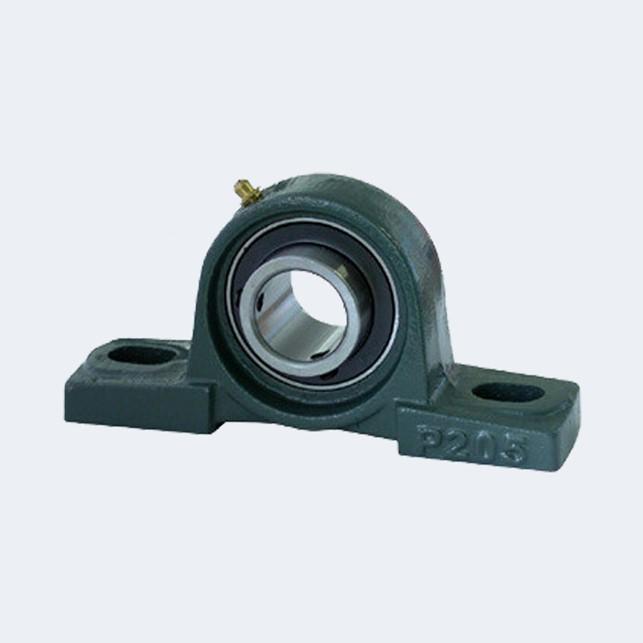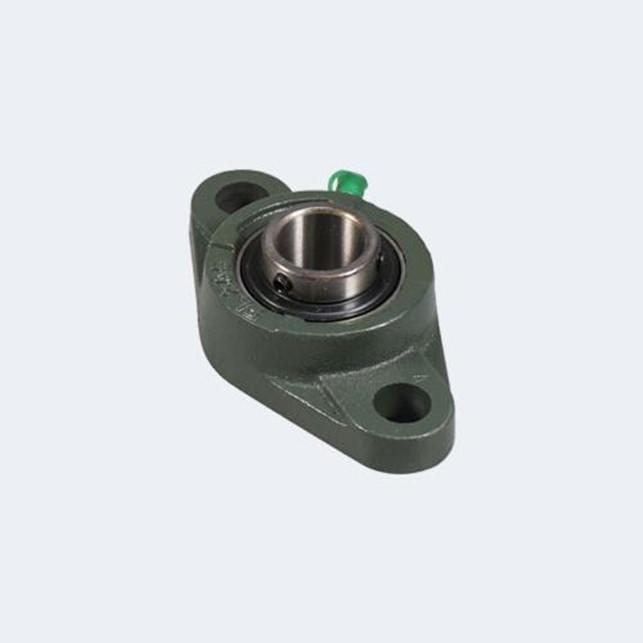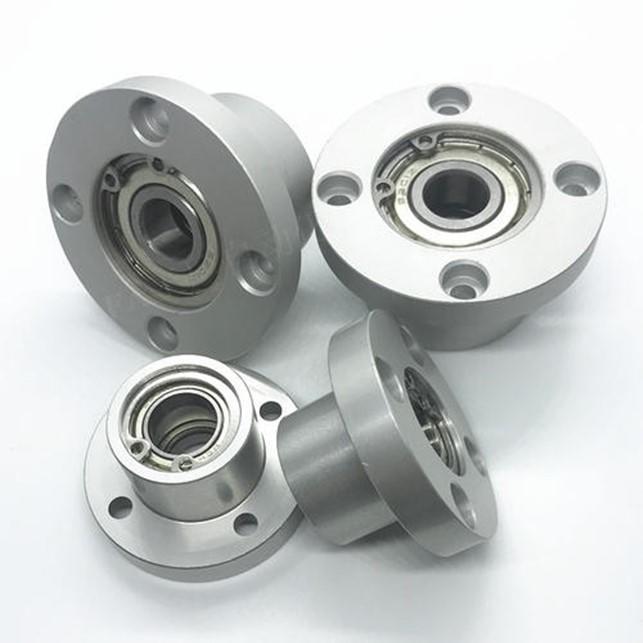
Pillow block bearing
The important construction methods of the slewing bearing seat are distinguished: four-point contact ball slewing bearing seat, double row angular contact thrust ball slewing bearing seat, interspersed cylindrical roller slewing bearing seat, interspersed tapered roller slewing bearing seat, three-row cylindrical roller fit Turntable bearing seat.
According to whether it can be equipped with teeth and the scattered parts of the gears, it is divided into different structures such as non-tooth type, external tooth type or internal tooth type.
Among them, the four-point contact ball slewing bearing seat has a high static load capacity, and the interspersed cylindrical roller slewing bearing seat has a higher dynamic load capacity. The interspersed tapered roller slewing bearing seat can improve the support rigidity and rotation accuracy by applying a preload. The three-row cylindrical rollers with the turntable bearing seat increase the height of the bearing seat to improve the bearing capacity. Different raceways can accept the load identification. Therefore, under the same stress condition, the diameter of the bearing seat can be greatly reduced. More compact, it is a slewing bearing seat with high load capacity.
The slewing bearing seat is generally used for large-scale rotary installation of lifting and transporting machinery, mining machinery, construction machinery, port machinery, marine machinery and high-precision radars.

The slewing bearing seat is a large and extra-large bearing seat that can accept comprehensive loads and has a special structure. It has the characteristics of compact structure, sensitive rotation, and convenient device maintenance. Where there is a bearing, there must be a support point. The inner support point of the bearing is the shaft, and the outer support is often referred to as the bearing seat.
The meaning of the bearing seat:
Since one bearing can choose different bearing seats, and one bearing seat can choose different types of bearings at the same time, there are many kinds of bearing seats. Bearing housings are included in Quick, Easy and Excellent, and many large foreign bearing companies also have their own housing catalogs. However, the markings of the same bearing seat model in different company samples are not exactly the same. For different applications of standard housings, housings of different materials can be selected, such as special housings made of gray cast iron, ductile iron, cast steel, stainless steel, and plastic.

Turntable structure:
The slewing bearing seat is a large and extra-large bearing seat that can accept comprehensive loads and has a special structure. It has the characteristics of compact structure, sensitive rotation, and convenient device maintenance. Compared with ordinary bearing housings, slewing bearing housings have the following obvious features:
1. Dimensions
The diameter is usually 0.4cm~10m, and the maximum can reach 40m.
2. High carrying capacity
Ordinary can accept axial load, radial load and overturning moment load together.
3. Low speed
The task speed is lower than 10r/min, and in a few cases, it does not rotate one after another, and only rotates within a certain angle to make a swing movement.
4. With bearing housing device hole
It can be fastened on the upper and lower supports with screws.
5. No pivot
The inner ring or outer ring has a gear for rotating drive.
6. With smooth oil hole and sealed installation.

common problem:
Wear problem
As the most common problem of bearing housing, wear and tear of bearing housing also occur frequently.
Repair method
Traditional methods generally use machining after surfacing to repair, and surfacing will cause the surface of the component to reach a high temperature, causing component deformation or cracks, and obtaining the size through machining will greatly extend the downtime. The use of polymer composite materials for on-site repair has no thermal influence, and the thickness of the repair is not limited. The wear resistance of the product and the concession that metal materials do not have, ensure 100% contact and coordination of the repair part and reduce equipment The shock and vibration avoid the possibility of wear. On-site repair, avoiding machining methods.
Repair process
Generally only four steps:
1. Surface treatment, the bearing seat surface will need to be repaired to remove oil and moisture;
2. Reconcile repair materials;
3. Apply the material, evenly apply the material to the repaired part of the bearing seat, and fill it firmly;
4. Wait for the material to solidify, and the surface of the material can be appropriately heated to accelerate the material solidification.
The general bearing chamber wear can be repaired in 3-6 hours. The operation is simple and easy to learn, no special equipment and special training are required. Compared with laser welding, cold welding and other technologies, it saves time and effort, and the cost is only 1/5 of the general repair cost. 1/10, on-site repair reduces equipment repair time and transportation costs.

Maintenance and maintenance of bearing seat
Pay special attention to the following points during the use of the bearing seat:
(1) Use of bearing seat cooling system. When the bearing seat cooling water is used correctly, it not only prolongs the service life of the bearing seat, but also improves production efficiency. The material of the bearing seat is generally made of special bearing seat steel through various treatments, and even the best bearing seat steel has its limits of use, such as temperature. When the bearing seat is in use, if the mold temperature is too high, it is easy to cause tortoise cracks on the surface of the mold core early. In some bearing seats, tortoise cracks appear on a large scale even before more than 2,000 molds. Even in the production of the bearing seat, because the temperature of the bearing seat is too high, the mold core has changed its color. After measurement, it even reaches more than 400 degrees. This temperature is prone to cracks when it is quenched by the release agent. The products are also prone to deformation, strain, and mold sticking. In the case of using the bearing seat cooling water, the use of release agent can be greatly reduced, so that the operator will not use the release agent to reduce the temperature of the bearing seat. The advantage is to effectively extend the life of the bearing seat, save the die-casting cycle, improve the product quality, reduce the occurrence of mold sticking, strain and aluminum sticking, and reduce the use of mold release agents. It can also reduce the loss of ejector rod and core caused by overheating of the bearing seat.
(2) The bearing seat must be preheated during the start of production to prevent the occurrence of turtle cracks when the cold bearing seat suddenly encounters hot molten metal. The more complicated bearing seat can be liquefied by a blowtorch. If the condition is good, use a mold temperature machine, and the relatively simple bearing seat can be preheated by slow injection.
(3) The cleaning of the parting surface of the bearing seat is very troublesome and easy to overlook. The operator should thoroughly clean the parting surface of the bearing seat with kerosene, which can not only prevent the bearing seat from being crushed, but also Moreover, after cleaning, the exhaust slot blocked by the residue of the release agent or other dirt on the bearing seat can be opened, which is beneficial to the discharge of gas in the cavity during the injection process and improves the product quality.
(4) If the bearing housing is equipped with neutron control, it is absolutely forbidden to connect the signal line between the die-casting machine and the bearing housing. The reason is clear. In daily production, it is difficult to avoid water on the signal line or The place where the joint is wrapped is easy to break, which will cause a short connection with the machine tool. If the signal is wrong, the alarm will automatically stop and delay the time, or the signal will be disordered and the bearing housing will be damaged. Cause unnecessary losses. Pay attention to the waterproof of the travel switch.

Motor bearing
1. Requirements for cleaning, inspection and insulation pad
1. Cleaning and inspection of bearing bush
The bearings of large motors are all packed and shipped separately. After unpacking, first take out the upper and lower bushings with eye screws and mark them and clean them with kerosene. Dry them with a dry cloth and check whether all grooves are clean and there is no casting residue sand. , The tungsten-gold layer is not well combined with the tile body, and there are blisters and other dopants in the grooves, cracks, etc.). If it cannot be repaired, re-attach tungsten gold.
2. Cleaning and inspection of bearing seat
The bearing seat should also be thoroughly cleaned and inspected before installation. Scrape the dirt off the inner cavity of the bearing housing with a scraper, wipe the dirt off with a cloth dipped in gasoline or solvent, and watch for cracks and blisters to prevent oil leakage during operation. The joint surface of the bearing cap and the bearing seat, and the joint surface of the bearing seat and the bearing oil retaining ring should be scraped and matched and checked with a feeler gauge. The gap should not be greater than 0.03 mm. The surface of the bottom plate on which the bearing seat is placed should also be cleaned, and there should be no bumps, rust and burrs. The screws that fasten the bearing seat and the threads of the seat plate must be carefully checked, and the screws should be tried to check whether they are too tight or bald.

3. Bearing insulation structure
An insulating backing plate or metal gasket must be used between the bearing and the bottom plate. The metal gasket is used to adjust the horizontal position of the seat. To adjust the relative position of the motor and another motor or machine connected to the phase. The metal gasket is made of 0.08~3mm thin metal plate. The insulating backing board is made of cloth laminate or glass fiber laminate. The purpose of placing an insulating backing plate is mainly to prevent the hazards of shaft current. The insulating backing plate should be 5~10mm wider than the bearing seat on each side, and the thickness should be 3~10mm. In addition to placing an insulating backing plate between the bearing and the bottom plate, the screws and stabilizing nails should also be insulated. The insulating washer is made of a glass cloth board with a thickness of 2 to 5 mm, and its outer diameter is 4 to 5 mm larger than that of the iron washer. The insulating pad of the oil pipe connecting plate connected with the bearing seat can be made of a rubber sheet with a thickness of 1 to 2 mm. After the insulated bearing seat is installed, the insulation resistance to ground should be checked, measured with a 500 volt megohmmeter, and its resistance value should be no less than 1 megohm.
Two installation
Both the single motor bearing and the multiple bearings of the unit should be installed on the main longitudinal axis of the connected machinery or the longitudinal axis of the unit. The center of the bearing is measured by the method of hanging wire and wire hammer. (A wooden strip is clamped in the arc of the bearing, and a thin iron strip is nailed to the center of the wooden strip to mark the center position).
To adjust the position of the shaft in the seat, start from the bearing seat on the outermost side, and place a level on the bearing seat surface to check the levelness of these planes. Use theodolite or level to check whether the planes of several shaft seats are in the same horizontal plane, and use a wire hammer to find out whether the centers of each bearing are on the same axis.

Adjust the bearing seat according to the above method. In the process of eliminating deviation, use jack-type tools to move the bearing seat. Do not use impact or hammering methods. Using this method to adjust the accuracy error of the bearing seat is about 0.5~1.0 mm. It should be pointed out that the installation adjustment of the bearing seat this time is only a pre-adjustment, and adjustment should be made during the centering to meet the requirements of consistent axis line. After the bearing seat is pre-adjusted, just tighten the screws evenly (according to the diagonal cycle), while the insulating sleeve and the stabilizing nails can be left temporarily, and they will be placed after the centering work is finally completed or before the test run.
High temperature bearing
Since high-temperature bearing housings must meet the requirements of high-precision stamped bearing housings and high-temperature stamping housings, the following two points need to be considered when considering the fit and clearance of high-temperature bearing housings:
1. Dimensional change and hardness change when rising from normal temperature to high temperature;
2. Force system change and shape change caused by centrifugal force at high speed.

The high temperature bearing seat requires that the part where the shaft and the seat hole are installed with the stamped bearing seat should have higher dimensional accuracy and shape accuracy than the general requirements, especially the coaxiality and the verticality of the shoulder to the seat hole or journal. , When considering these issues, we must pay attention to the high-speed factors and high-temperature factors during high-temperature bearing seat operation.
The high-temperature bearing seat is required to have the best clearance under the working condition, that is, at the working temperature, and this clearance is formed under the state of precise alignment of the inner and outer ring ball groove centers. At the same time, since the high temperature bearing seat strives to reduce relative sliding and internal friction, it is best not to adjust the clearance of the high temperature bearing seat by relatively displacing the inner and outer rings in the axial direction.

The best service from our transmission drive expert to your inbox directly.
Our Service
Get in Touch
Yantai Bonway Manufacturer Co.ltd
ANo.160 Changjiang Road, Yantai, Shandong, China(264006)
T+86 535 6330966
W+86 185 63806647